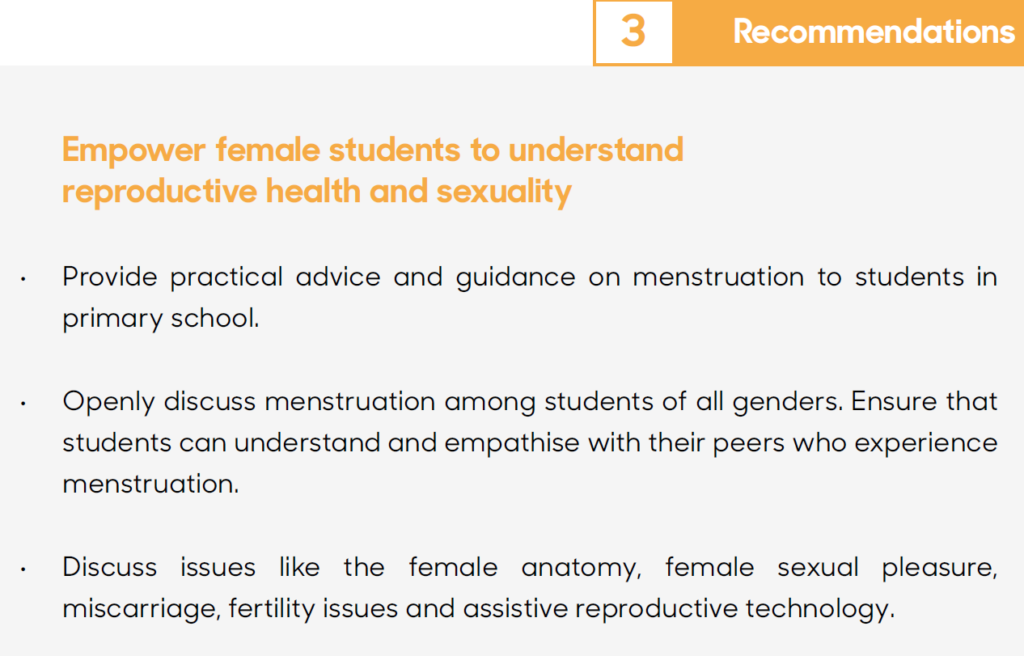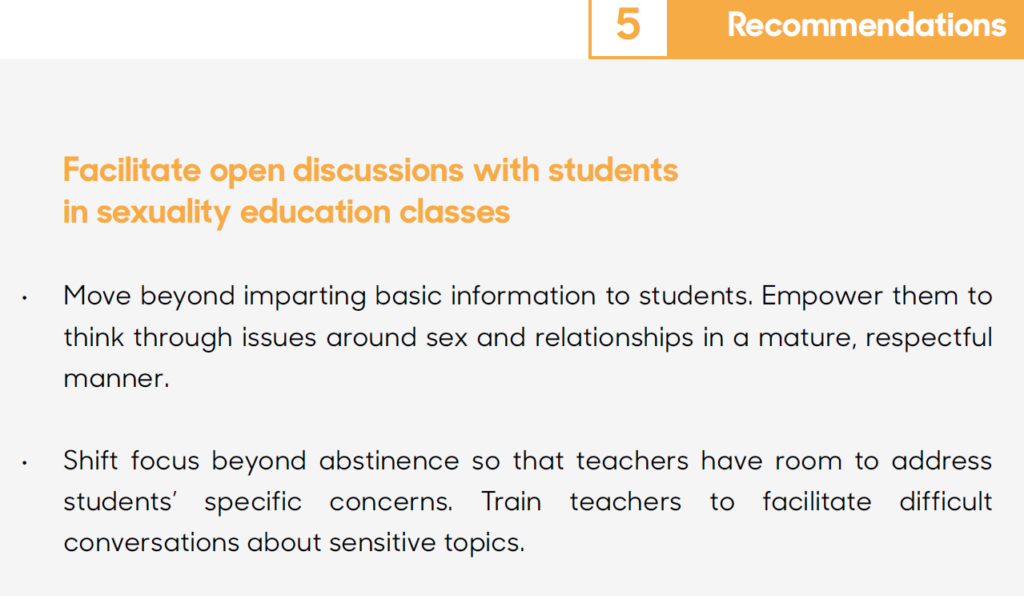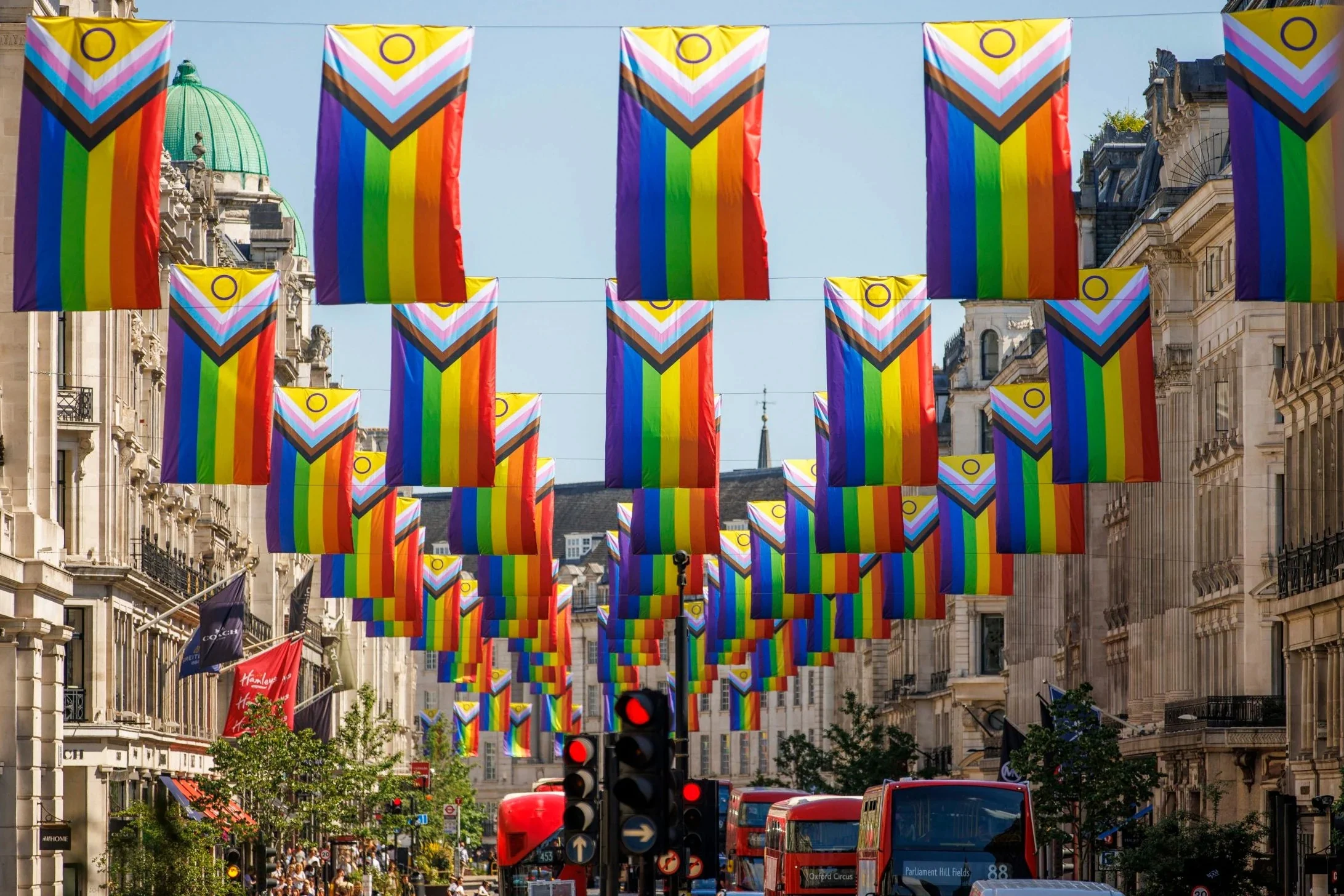
Is AWARE aware of the harms of CSE?
AWARE recommends that the Ministry of Education change its sexuality education to align with the UN ITGSE.
The harms of the UN ITGSE are here:

Other recommendations that AWARE should clarify
AWARE recommends to “Openly discuss menstruation among students of all genders.”
How many “genders” does AWARE think there are? And which genders menstruate?
Children should also discuss “female sexual pleasure”.
Isn’t teaching sexual pleasure to children or teenagers age-inappropriate? Does AWARE believe that sexual pleasure should be enjoyed exclusively within marriage?

Children should have “respect” for identities based on sex, gender, gender identity, and sexual orientation.
AWARE wants children to go beyond respect for the individuals to respect their self-described identity.
This means that children must accept each other’s gender identities and sexual orientations as legitimate identities. Classrooms will then become permissive of exploring these psychological identities.
Children should also be taught about the “LGBTQ community”.
What is included in such “education”? Must children be taught that LGBTQ individuals are born this way and therefore they cannot change?
Must children be taught that LGBTQ individuals should be allowed same-sex unions, same-sex “parenting” and other policy changes that fit the LGBTQ lifestyles?
Children should be taught to respect different choices due to “asexuality”.
Asexuality does not need to be emphasised as a separate “sexual identity” in order for people to appreciate the value of staying free from sexual activity.

Children should think through issues around sex and relationships.
What kind of issues around sex and relationships should children or teenagers talk about? AWARE is not sufficiently clear.
Teachers should shift focus beyond abstinence to address specific concerns.
What does “beyond abstinence” mean? Does it mean teaching children about sex outside of marriage?
Why is it the teacher’s job to address “specific concerns” or “sensitive topics”? Do children’s concerns have a universally accepted answer? Or do they have different answers depending on the children’s worldview, values, religions and cultures? From which worldview will teachers facilitate such a discussion? Can any teacher be free from bias or presuppositions?
How can MOE be realistically expected to ensure that educators can appropriately facilitate such discussions in a way that does not cause a divide between the children and their parents?


CSE Harms by Age
In this article, we highlight the most blatant harms of CSE across age groups.
However, many harms are incremental and well-hidden, which require deeper analysis. To understand these harms, you may explore our analysis by topic.
All Topics
1.1 Families
1.2 Friendship, Love and Romantic Relationships
1.3 Tolerance, Inclusion and Respect
1.4 Long-term Commitments and Parenting
2.1 Values and Sexuality
2.2 Human Rights and Sexuality
2.3 Culture, Society and Sexuality
3.1 The Social Construction of Gender and Gender Norms
3.2 Gender Equality, Stereotypes and Bias
3.3 Gender-based Violence
4.1 Violence
4.2 Consent, Privacy and Bodily Integrity
4.3 Safe Use of Information and Communication Technologies (ICTs)
5.1 Norms and Peer Influence on Sexual Behaviour
5.2 Decision-making
5.3 Communication, Refusal and Negotiation Skills
5.4 Media Literacy and Sexuality
5.5 Finding Help and Support
6.1 Sexual and Reproductive Anatomy and Physiology
6.2 Reproduction
6.3 Puberty
6.4 Body Image
7.1 Sex, Sexuality and the Sexual Life Cycle
7.2 Sexual Behaviour and Sexual Response
8.1 Pregnancy and Pregnancy Prevention
8.2 HIV and AIDS Stigma, Treatment, Care and Support
8.3 Understanding, Recognizing and Reducing the Risk of STIs, including HIV

Stay Updated about CSE Harms
To be forewarned is to be forearmed.
No spam. No sales. Only Resources.

